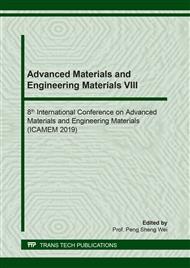[1]
S.E.S. Bariran, K.S.M. Sahari, A comparative bibilometric analysis of Taguchi-centered optimization in plastic injection moulding, Jurnal. Teknologi. 41(1) (2014) 1-16.
DOI: 10.11113/jt.v68.3000
Google Scholar
[2]
G.J. Kang, C.H. Park, D.H. Choi, Metamodel-based design optimization of injection molding process variables and gates of an automotive glove box for enhancing its quality, J. Mech. Sci. Techno. 30 (4) (2016) 1723-1732.
DOI: 10.1007/s12206-016-0328-x
Google Scholar
[3]
S. Sudsawat, W. Sriseubsai, Optimized plastic injection molding process and minimized the warpage and volume shrinkage by response surface methodology with genetic algorithm and firefly algorithm techniques, Indian J. Eng. Mater. Sci. 47(9) (2017) 228-238.
Google Scholar
[4]
K.H. Kim, J.C. Park, Y.S. Suh, B.H. Koo, Interactive robust optimal design of plastic injection products with minimum weldlines, Int. J. Adv. Manuf. Technol. 88 (2017) 1333–44.
DOI: 10.1007/s00170-016-8854-3
Google Scholar
[5]
C.Y. Wu, C.C. Ku, H.Y. Pai, Injection molding optimization with weld line design constraint using distributed multi-population genetic algorithm, Int. J. Adv. Manuf. Technol. 52 (2011) 131–41.
DOI: 10.1007/s00170-010-2719-y
Google Scholar
[6]
W.C. Chen, D. Kurniawan, G.L. Fu, A two-stage optimization system for the plastic injection molding with multiple performance characteristics, Adv. Mater. Res. 468-471 (2012) 386-390.
DOI: 10.4028/www.scientific.net/amr.468-471.386
Google Scholar
[7]
F. Yin, H. Mao, L. Hua, W. Guo, Shu M, Back-propagation neural network modeling for warpage prediction and optimization of plastic products during injection molding, Mater. Des. 32(4) (2011) 1844-1850.
DOI: 10.1016/j.matdes.2010.12.022
Google Scholar
[8]
S. Kitayama, K. Tamada, M. Takano, S. Aiba, Numerical optimization of process parameters in plastic injection molding for minimizing weldlines and clamping force using conformal cooling channel, J. Manuf. Process 32 (2018) 782-790.
DOI: 10.1016/j.jmapro.2018.04.007
Google Scholar
[9]
K.M. Tsai, C.Y. Hsieh, W.C. Lo, A study of the effects of process parameters for injection molding on surface quality of optical lenses, J. Mater. Processing. Tech. 209(7) (2008) 3469-3477.
DOI: 10.1016/j.jmatprotec.2008.08.006
Google Scholar
[10]
J.J. Mostafa, M.A. Mohammad, Ehsan M, A hybrid response surface methodology and simulated annealing algorithm: a case study on the optimization of shrinkage and warpage of a fuel filter, World. Appl. Sci. J. 13 (10) (2011) 2156-2163.
Google Scholar
[11]
H. Zhenpeng, S. Yigang, Z. Guichang, H. Zhenyu, X. Weisong, L. Xin, Z. Junhong, Tribilogical performances of connecting rod and by using orthogonal experiment, regression method and response surface methodology, Appl. Soft. Comput. 29 (2015) 436-449.
DOI: 10.1016/j.asoc.2015.01.009
Google Scholar
[12]
C.J. Tzeng, Y.K. Yang, Y.H. Lin, C.H. Tsai, A study of optimization of injection molding process parameters for SGF and PTFE reinforced PC composites using neural network and response surface methodology, Int. J. Adv. Manuf. Technol. 63 (2012) 691-704.
DOI: 10.1007/s00170-012-3933-6
Google Scholar
[13]
G. Xu, Z. Yang, G. Long, Multi-objective optimization of MIMO plastic injection molding process conditions based on particle swarm optimization, Int. J. Adv. Manuf. Technol. 58 (2012) 521-531.
DOI: 10.1007/s00170-011-3425-0
Google Scholar
[14]
W.C. Chen, P.H. Liou, S.C. Chou, An integrated parameter optimization system for MIMO plastic injection molding using soft computing, Int. J. Adv. Manuf. Technol. 73 (2014) 1465-1474.
DOI: 10.1007/s00170-014-5941-1
Google Scholar
[15]
W.C. Chen, D. Kurniawan, Process parameters optimization for multiple quality characteristics in plastic injection molding using Taguchi method, BPNN, GA, and hybrid PSO-GA, Int. J. Prec. Eng. Manuf. 15(8) (2014) 1583-1593.
DOI: 10.1007/s12541-014-0507-6
Google Scholar
[16]
W.C. Chen, M.H. Nguyen, W.H. Chiu, T.N. Chen, P.H. Tai, Optimization of the plastic injection molding process using Taguchi method, RSM, hybrid GA-PSO, Int. J. Adv. Manuf. Technol. 88 (2016) 1873-1886.
DOI: 10.1007/s00170-015-7683-0
Google Scholar


